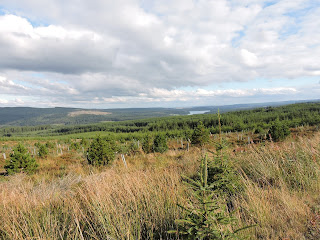The solstice is
past. The year has turned. The feeling that the days will get
longer,the nights shorter and that winter is in retreat is, of
course, false. The worst of the weather may still be to come and
the lengthening of the daylight hours won't be apparent for many
weeks but it feels that we have made it to the real turn of the year.
To celebrate the
shortest day, I went out to visit the Duddo Stones. Five of the
original seven still stand on a small hillock surrounded by a
panorama of all the major hills in the surrounding area. A perfect
site to be at one with the elements.
 |
| Sunrise at the Duddo Stones |
It was, no doubt,
the first farmers who erected the stones, four thousand years ago
when the seasonal round of the hunter-gatherers changed to a settled
permanence and the land and the people were bound together in one
place.
Eroded by wind and
rain the stones with deep channels, they are sometimes called the
"Singing Stones" when the Northumbrian wind whistles past
them resonating in their grooved surfaces.
 |
| The deeply grooved "singing stones" |
There are what
appear to be cup marks on two of the uprights like those seen on so
many stones in this area. Perhaps they were already on the stones
before they were chosen for this henge.
 |
| Cup marks on one of the stones |
They could be from
an earlier time but recognised by the circle builders as having such
significant powers that they incorporated them into their own sacred
site.
All religions tend
to use the trappings and symbols of earlier beliefs .
What the belief
system of the people who erected the Duddo Stones was, we cannot know
but I'm sure the marking of the solstice would have been part of it.
Maybe they took
evergreens into their homes, ate special foods, lit fires and
torches and told ancient tales and exchanged gifts to cheer
themselves in the darkness of mid-winter. They would have been just
like us, glad to be warm and well fed, waiting for the spring and
resolving to do better next year.















































